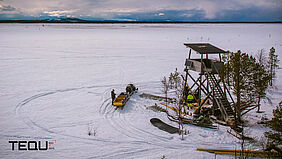From North to South, energy usage is completely different across Europe, and it varies a lot from summer to winter months as well. Let’s start exploring the most northern areas where the sun does not rise at all during the present months!
Let’s virtually travel to the Finnish Lapland, where the winter usually starts in October, or early November, and it finishes in March. Did you know that in some northern parts, the sun does not rise at all for 53 days? Yes, you are reading it right, the average daylight hours are 0 in many areas of the Northern Periphery and Arctic. If we had to describe the weather during winter in Lapland with three words, we would mention: ‘snow’, ‘cold’ and ‘dark’. “At this time of the year we basically don’t have any sunlight for a couple of weeks, for example, today the sun rises at 11:04 and it goes down at 13:22”, explains our project partner Hannu Korhonen, from Lapland University of Applied Sciences.
Korhonen adds that, the average temperature during the day is about -10 degrees and it decreases up to -20 degrees at night. You might be continuously thinking about snow and you would be right. The typical weather during winter months in Lapland includes sunshine, rain, moderate and strong winds and snow, a lot of it… “We still have snow after March, but the temperatures are above zero, so it is spring with snow until late April”, states our SMARCTIC project partner. He mentions that temperatures can be as low as -30 but, “nowadays that is not as common as it used to be a couple of decades ago. Climate is changing…”.
With this climatology, Hannu Korhonen explains that the average time spent indoors is about 20h per day. Therefore, heating becomes a necessity not only in public buildings, but also for the households. The main energy sources used during winter months are produced by the local energy company, which produces heat mainly from burning wood chips and peat. Asked about producing energy from melting the snow, our partner explains that they don’t do it: “We have had some research in melting snow from solar panels, so the panels would produce energy in winter but still the melting process uses more energy that can be gained from the panels”.
Hannu Korhonen adds that there are not any specific strategies, targets for reducing energy expenditure in the winter months when usage is higher “because most of the energy goes into heating and all the houses require a lot of heating in these cold months”. “Right now, we have about 20cm of snow, but most of it will come in February/March so in the end of the winter we will probably have almost one meter of snow”.
Through the SMARCTIC project, our partners are trying to find out new ways to influence the people using some facilities to act in a more energy sensible manner. "We are trying to find new ways to use modern technology to help maintaining the public buildings energy usage proactively", continues Hannu. SMARCTIC partners conduct energy audits in different buildings to find out what are the main causes for high energy consumption. "For example, Santasport (a sports, education and recreation centre in Rovaniemi) has a spa and multiple changing rooms with showers so their water consumption is high. We are planning to install water flow meters with “traffic lights” directly to the showers so we could influence people not to shower too long. At Ounashalli (an indoor football arena) we are monitoring the indoor and outdoor temperatures to find out how the indoor temperature changes when the outdoor temperature gets cold very fast (it can drop 20 degrees overnight). The question is, can we use weather forecasts and teach the heating system to act proactively according to the forecasts? We are also doing calculations for the pilot community if they could build a joint solar panel field to create green energy for themselves", concludes Hannu.
The SMARCTIC project provides an integrated platform that allows citizens, universities, companies and public authorities to work together in their community to reduce energy usage.
Stay tuned!


